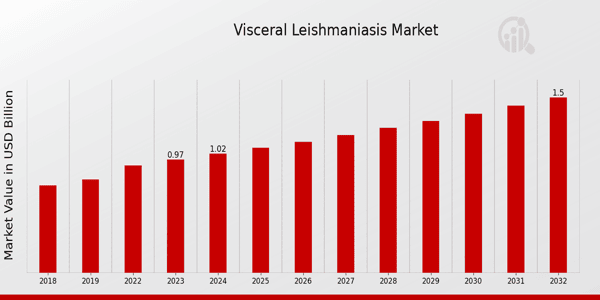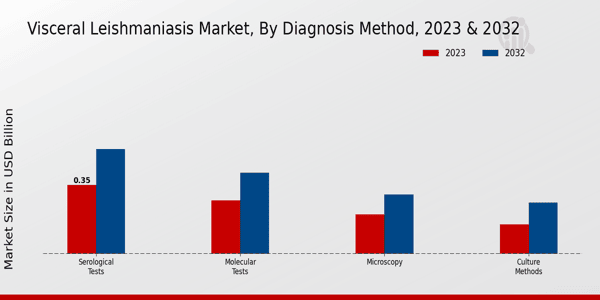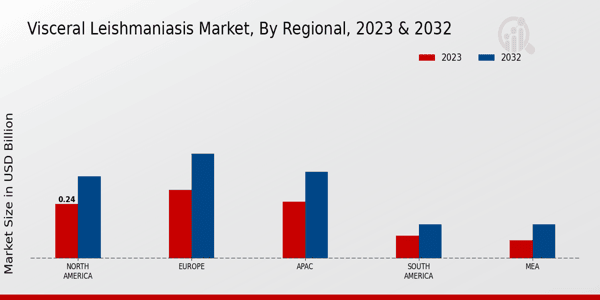Visceral Leishmaniasis Market Overview:
As per MRFR analysis, the Visceral Leishmaniasis Market Size was estimated at 1.06 (USD Billion) in 2024. The Visceral Leishmaniasis Market Industry is expected to grow from 1.12 (USD Billion) in 2025 to 1.72 (USD Billion) till 2034, at a CAGR (growth rate) is expected to be around 4.95% during the forecast period (2025 - 2034)..
Key Visceral Leishmaniasis Market Trends Highlighted
The Visceral Leishmaniasis Market is influenced by several key drivers, including an increase in disease awareness, advancements in diagnostic methods, and the development of effective treatment options. The rise in global travel and migration is also contributing to the spread of the disease, leading to greater demand for interventions. Ongoing research efforts aimed at understanding the disease better are expected to boost the market. Furthermore, collaborations between governments and organizations to improve health infrastructure in endemic regions are vital for enhancing treatment availability and accessibility. Opportunities exist in the expansion of vaccination programs and the introduction of novel therapeutic agents.
There is a need for enhanced preventive measures in high-risk regions, which can help mitigate the disease's impact. Innovative technologies, such as point-of-care diagnostics and telemedicine, present avenues to improve healthcare delivery in remote areas. Additionally, public-private partnerships can facilitate the development of affordable treatments, making them more accessible to affected populations. A stronger focus on outreach programs can promote awareness and education about the disease, driving community engagement in prevention efforts. Recent trends indicate an increase in research funding and novel approaches to disease management.
The integration of technology in healthcare delivery is transforming how patients are diagnosed and treated. Additionally, more emphasis is being placed on community-based solutions that involve local populations in combating visceral leishmaniasis. Sustainable development goals and initiatives targeting neglected tropical diseases are gaining momentum, further reinforcing the importance of tackling this often-overlooked condition. Increased collaborations among stakeholders in health sectors are essential for ensuring comprehensive responses to the challenges posed by visceral leishmaniasis. These collective efforts aim to not only manage existing cases but also prevent new infections from occurring.

Source: Primary Research, Secondary Research, MRFR Database and Analyst Review
Visceral Leishmaniasis Market Drivers
Increasing Incidence of Visceral Leishmaniasis
The Visceral Leishmaniasis Market Industry is experiencing a significant rise in the incidence of visceral leishmaniasis, particularly in tropical and subtropical regions. Increasing today’s progress activities such as climate change, urbanization, and deforestation are causing the global spread of the disease, which in turn leads to an increase in the infections numbers. The progressive rise in immunocompromised populations, and more specifically HIV-positive individuals, has increased the prevalence of this disease as well.
There has been an increase in the focus by government and health organizations towards tackling visceral leishmaniasis as a result of its public health effects, which in turn is facilitating investments in R&D. This emerging focus on improving diagnosis, increasing treatment options and implementing preventive measures is expected to foster significant growth in the market. Furthermore, improvement in the awareness around the disease visceral leishmaniasis and its effect on health has done great justice to the funding of public health programs, further igniting growth in the Visceral Leishmaniasis Market Industry.
There is also the expectation that such conditions will be created as a result of the initiatives by worldwide health organizations targeting the eradication of such diseases as visceral leishmaniasis via vaccination and the creation of appropriate treatments that will provide a favorable atmosphere for the growth of the market. Health officials emphasize that more emphasis on surveillance and monitoring of the disease may also improve intervention timeliness, which may further lead to better management of visceral leishmaniasis and its symptoms. As the case load continues to show an upward trend, it is likely that stakeholders will encounter an increased need for effective therapeutics and solutions, leading to the expansion of the market.
Advancements in Treatment Options
Advancements in the treatment options for visceral leishmaniasis are another key driver shaping the Visceral Leishmaniasis Market Industry. The introduction of new drugs and therapies with improved efficacy and lower toxicity profiles contributes significantly to improving patient outcomes. Research into alternative treatment methods is ongoing, including the development of vaccines that could significantly change the landscape of visceral leishmaniasis treatment and prevention.
Strategic partnerships between pharmaceutical companies and research institutions are fostering innovation in drug development, catering to the urgent need for effective and safe treatment alternatives. As more therapeutic options become available, healthcare providers are likely to adopt new treatments, thus enhancing the overall market growth.
Increased Government Initiatives and Funding
Governments and international organizations are increasingly recognizing visceral leishmaniasis as a critical public health issue, leading to enhanced initiatives and funding aimed at combating the disease. Collaborative efforts between nations to control and eliminate visceral leishmaniasis through targeted health programs and improving healthcare infrastructure directly influence the Visceral Leishmaniasis Market Industry. Such initiatives often include funding for research projects focused on new diagnostic methods, treatment options, and public awareness campaigns.The increased allocation of resources towards combating vector-borne diseases like visceral leishmaniasis is pivotal for future market growth.
Visceral Leishmaniasis Market Segment Insights:
Visceral Leishmaniasis Market Diagnosis Method Insights
The Diagnosis Method segment of the Visceral Leishmaniasis Market plays a crucial role in identifying and managing the disease effectively. In 2023, the overall market for this segment is valued at 0.97 USD billion, reflecting the vital need for accurate and timely diagnosis in combating visceral leishmaniasis. Among the different methodologies, Serological Tests stand out with a valuation of 0.35 USD billion in 2023, projected to grow to 0.53 USD billion by 2032. This dominance can be attributed to their ability to provide rapid results and high sensitivity, making them essential in endemic regions where timely intervention is critical.
Following closely, Molecular Tests are valued at 0.27 USD billion in 2023 and are expected to increase to 0.41 USD billion by 2032. The significance of Molecular Tests lies in their enhanced specificity and capability to detect the pathogen's genetic material, offering a precise diagnosis that is vital for effective treatment planning. Microscopy, with a valuation of 0.20 USD billion in 2023, is projected to rise to 0.30 USD billion by 2032, serving as a fundamental diagnostic tool that leverages traditional methods to identify parasites through direct visualization.
Despite its effectiveness, it faces challenges such as the need for skilled personnel and time-intensive procedures. Culture Methods, valued at 0.15 USD billion in 2023 and expected to grow to 0.26 USD billion by 2032, play a critical role in confirming diagnoses but are less frequently utilized due to longer turnaround times and technical complexities. Overall, the insights from the Visceral Leishmaniasis Market data highlight the distinct importance of these diagnosis methods, where Serological Tests are dominant due to their rapidity and accessibility, while Molecular Tests are gaining traction for their accuracy.
The ongoing market growth is driven by increasing awareness of visceral leishmaniasis, supportive government initiatives, and advancements in diagnostic technologies, although challenges such as resource limitations and the need for trained professionals remain prevalent. The landscape of the Visceral Leishmaniasis Market statistics reflects a collective effort to enhance the diagnosis and treatment of this serious disease, integrating a variety of methods to meet the diverse needs of affected populations effectively.

Source: Primary Research, Secondary Research, MRFR Database and Analyst Review
Visceral Leishmaniasis Market Treatment Type Insights
The Visceral Leishmaniasis Market, valued at approximately 0.97 USD Billion in 2023, showcases a significant emphasis on various Treatment Types, which play a pivotal role in addressing this infectious disease. Key Treatment Types include Antimonials, Amphotericin B, Miltefosine, and Paromomycin, each contributing notably to the overall market dynamics. Antimonials continue to be a critical treatment option owing to their established efficacy, while Amphotericin B is often favored for severe cases, demonstrating robust effectiveness across diverse patient profiles.
Miltefosine, as an oral treatment, enhances patient compliance and expands treatment accessibility, making it a crucial option in managing visceral leishmaniasis. Paromomycin, on the other hand, holds significance due to its cost-effectiveness and potential for use in resource-limited settings, considerably impacting treatment strategies in endemic regions. The focus on these treatment modalities reflects growing awareness and efforts to improve patient outcomes while addressing the challenges posed by drug resistance and treatment accessibility.
Insights from Visceral Leishmaniasis Market data underscore the necessity to adapt treatment approaches, leveraging advancements and research to combat this emerging health challenge effectively. As the market continues to evolve, these Treatment Types will remain instrumental in shaping the Visceral Leishmaniasis Market industry landscape as they cater to diverse patient needs and regional healthcare implementations.
Visceral Leishmaniasis Market End User Insights
The End User segment of the Visceral Leishmaniasis Market plays a crucial role in the management and treatment of this disease. As of 2023, the overall market is valued at 0.97 billion USD, reflecting a growing demand for effective interventions. Hospitals are essential in providing acute care and treatment innovations, serving as critical access points for patients. Diagnostic Laboratories contribute significantly to disease identification and monitoring through advanced testing methodologies, thus playing a vital role in early detection and management.
Research Institutions are increasingly important for developing new therapies and enhancing existing treatment protocols, driving the market forward. Together, these entities not only contribute to the overall market growth but also provide a foundation for advancements in Visceral Leishmaniasis care, making this segment integral to public health strategies against this condition. The increasing number of cases, coupled with the rising need for effective diagnostics and treatment options, significantly bolsters the significance of these end users in the overall landscape of the Visceral Leishmaniasis Market revenue and industry dynamics.
Visceral Leishmaniasis Market Regional Insights
The Visceral Leishmaniasis Market exhibits regional segmentation that reflects diverse market dynamics, with North America holding a valuation of 0.24 USD Billion in 2023, projected to reach 0.36 USD Billion in 2032. Europe follows closely, valued at 0.30 USD Billion in 2023, and is expected to grow to 0.46 USD Billion by 2032, showing significant market growth potential. The APAC region contributes 0.25 USD Billion in 2023, anticipated to rise to 0.38 USD Billion, indicating substantial interest in infectious disease management in this emerging market.
South America, while smaller, holds a valuation of 0.10 USD Billion in 2023, forecasted to increase to 0.15 USD Billion, reflecting growing awareness and healthcare initiatives. The MEA region, possessing the least market size at 0.08 USD Billion in 2023 but is projected to attain 0.15 USD Billion, underscores the rising healthcare focus within disease-affected areas. These statistics provide valuable insights into the Visceral Leishmaniasis Market revenue, highlighting how North America and Europe dominate within market growth while APAC presents opportunities for expansion due to increasing healthcare access and awareness.Factors like urbanization and climate alteration are contributing to market trends, while challenges such as limited treatment options persist.

Source: Primary Research, Secondary Research, MRFR Database and Analyst Review
Visceral Leishmaniasis Market Key Players and Competitive Insights:
The Visceral Leishmaniasis Market is characterized by a dynamic competitive landscape driven by various factors, including advancements in drug development, increasing awareness about the disease, and the urgent need for effective treatment options. Companies operating within this market are focusing on research and development to create novel therapies that not only combat the disease efficiently but also improve patient outcomes. Furthermore, collaborations and partnerships among pharmaceutical companies and research institutions are fostering innovation and the expansion of product lines. Regulatory approvals and the adoption of combination therapies also play significant roles in shaping the competitive dynamics of this market, making it crucial for involved entities to stay ahead with strategic initiatives.
Sanofi has a notable presence in the Visceral Leishmaniasis Market, primarily due to its commitment to developing effective treatments for neglected tropical diseases. One of its key strengths lies in its extensive research capabilities and a robust pipeline of therapies specifically targeting visceral leishmaniasis, significantly contributing to improving patient care in endemic regions. The company's established distribution network allows for efficient delivery of treatments, ensuring accessibility where it is most needed. Sanofi's focus on collaboration with global health organizations further enhances its market position, leveraging partnerships to implement sustainable health initiatives. This multi-faceted approach allows Sanofi to maintain a competitive edge in a thriving market environment while also addressing the substantial public health concern posed by visceral leishmaniasis.
Bayer is another significant player in the Visceral Leishmaniasis Market, known for its strong commitment to combating neglected tropical diseases and a diversified portfolio of pharmaceutical offerings. One of Bayer’s key strengths is its extensive experience in drug development and commercialization, which aids in the swift delivery of effective solutions for visceral leishmaniasis. The company utilizes advanced research techniques and embraces innovation to enhance its treatment options, which increases its appeal in regions severely afflicted by the disease. Bayer's strategic collaborations with non-profit organizations and governments further fortify its market presence, allowing for the introduction of innovative access strategies aimed at delivering treatments to the most affected populations. This proactive stance helps Bayer to not only address immediate healthcare needs but also to contribute to broader global health objectives.
Key Companies in the Visceral Leishmaniasis Market Include:
- Sanofi
- Bayer
- Johnson and Johnson
- GlaxoSmithKline
- Merck and Co
- Gilead Sciences
- Novartis
- Amgen
- AbbVie
- BristolMyers Squibb
- Eisai
- Astellas Pharma
- Takeda Pharmaceutical
- Roche
- Pfizer
Visceral Leishmaniasis Market Industry Developments
Recent developments in the Visceral Leishmaniasis Market have showcased significant efforts by pharmaceutical companies to address the disease and its implications. Companies such as Sanofi, Bayer, Johnson & Johnson, and Gilead Sciences are focusing on innovative treatment options and expanding their research into neglected tropical diseases, particularly in endemic regions. The market has witnessed an increased valuation attributable to a surge in funding for research and development initiatives aimed at finding effective therapies. Notably, Bayer and GlaxoSmithKline have collaborated on several fronts to bring new treatments to market.
In terms of mergers and acquisitions, recent trends have shown a consolidation of resources as companies like Merck & Co. and Novartis strategize to combine expertise in vaccine development and therapeutic solutions for visceral leishmaniasis. There has been growing emphasis on public-private partnerships to enhance accessibility to treatments and improve healthcare infrastructure in affected areas. Overall, the market is currently characterized by a blend of innovation, strategic collaborations, and proactive measures taken by pharmaceutical giants, reflecting a robust response to the challenges posed by visceral leishmaniasis.
Visceral Leishmaniasis Market Segmentation Insights
- Visceral Leishmaniasis Market Diagnosis Method Outlook
- Serological Tests
- Molecular Tests
- Microscopy
- Culture Methods
- Visceral Leishmaniasis Market Treatment Type Outlook
- Antimonials
- Amphotericin B
- Miltefosine
- Paromomycin
- Visceral Leishmaniasis Market End User Outlook
- Hospitals
- Diagnostic Laboratories
- Research Institutions
- Visceral Leishmaniasis Market Regional Outlook
- North America
- Europe
- South America
- Asia Pacific
- Middle East and Africa
| Report Attribute/Metric |
Details |
|
Market Size 2024
|
1.06 (USD Billion)
|
|
Market Size 2025
|
1.12 (USD Billion)
|
|
Market Size 2034
|
1.72 (USD Billion)
|
|
Compound Annual Growth Rate (CAGR)
|
4.95 % (2025 - 2034)
|
|
Report Coverage
|
Revenue Forecast, Competitive Landscape, Growth Factors, and Trends
|
|
Base Year
|
2024
|
|
Market Forecast Period
|
2025 - 2034
|
|
Historical Data
|
2020 - 2024
|
| Market Forecast Units |
USD Billion |
| Key Companies Profiled |
Sanofi, Bayer, Johnson and Johnson, GlaxoSmithKline, Merck and Co, Gilead Sciences, Novartis, Amgen, AbbVie, BristolMyers Squibb, Eisai, Astellas Pharma, Takeda Pharmaceutical, Roche, Pfizer |
| Segments Covered |
Diagnosis Method, Treatment Type, End User, Regional |
| Key Market Opportunities |
Innovative treatment development, Enhanced diagnostic tools, Growing global awareness campaigns, Expansion into endemic regions, Public-private partnership initiatives |
| Key Market Dynamics |
Increasing disease prevalence, Government funding initiatives, Advancements in treatment options, Rising awareness programs, Emerging research collaborations |
| Countries Covered |
North America, Europe, APAC, South America, MEA |
Frequently Asked Questions (FAQ) :
The Visceral Leishmaniasis Market is expected to be valued at 1.5 USD Billion in 2034.
The projected CAGR for the Visceral Leishmaniasis Market from 2025 to 2034 is 4.95%.
By 2034, North America is anticipated to dominate the Visceral Leishmaniasis Market with a value of 0.36 USD Billion.
The market size for Serological Tests is expected to reach 0.53 USD Billion in 2034.
Major players in the Visceral Leishmaniasis Market include Sanofi, Bayer, Johnson and Johnson, and GlaxoSmithKline.
The market size for Molecular Tests is projected to reach 0.41 USD Billion by 2034.
The APAC region is expected to be valued at 0.38 USD Billion in the Visceral Leishmaniasis Market by 2032.
The market value for Culture Methods is expected to be 0.26 USD Billion in 2034.
South America is anticipated to reach a market size of 0.15 USD Billion by 2032.
The market value for Microscopy is projected to be 0.3 USD Billion in 2034.

















